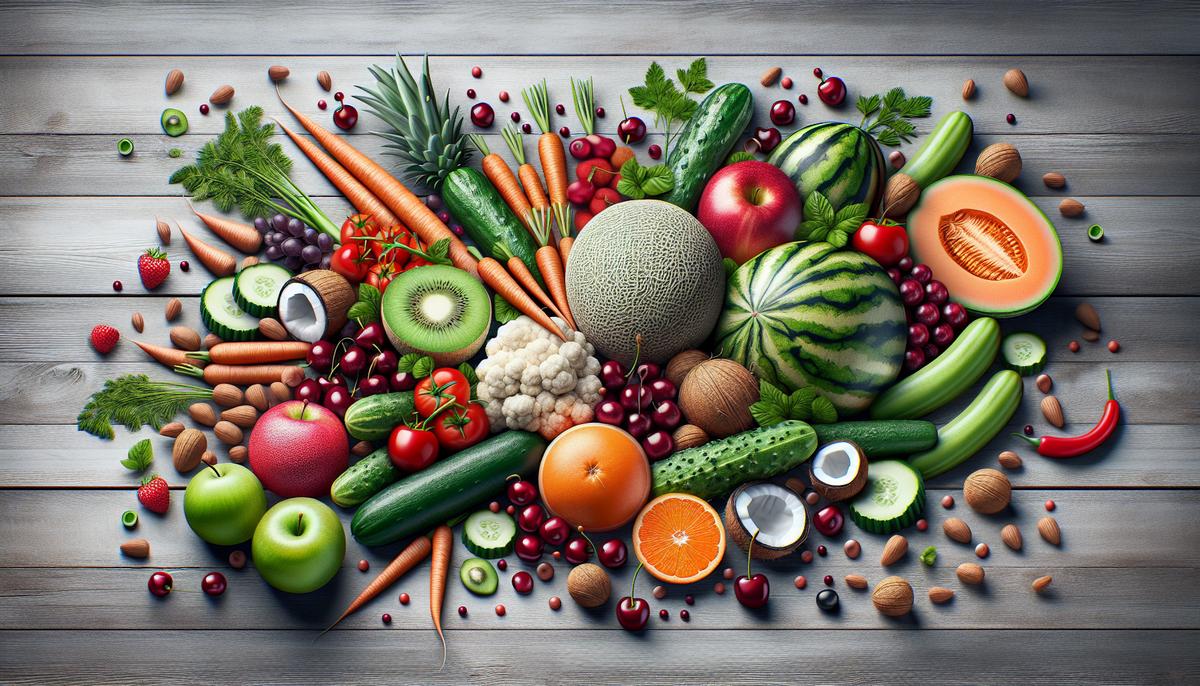As a health-conscious foodie, discovering new fruits and vegetables can be a delightful adventure. Today, we’re exploring a vibrant selection of fruits and vegetables that start with the letter P. Each offers its unique set of flavors, textures, and nutritional benefits. Whether you’re looking to broaden your culinary horizons or enhance your diet with nutrient-rich options, this guide will provide you with detailed insights into these fantastic foods. From the tropical sweetness of papayas to the earthy richness of parsnips, let’s get excited about incorporating these “P” foods into our daily meals!
Fruits that start with P
Papaya
Papayas are tropical fruits with a soft, buttery texture and a sweet, musky flavor. Native to Central America, they are now grown in tropical climates worldwide. The vibrant orange flesh and black seeds make them visually appealing and perfect for fruit salads or smoothies.
Nutritionally, papayas are a powerhouse of vitamins and enzymes. They are rich in vitamin C, providing more than 100% of the daily recommended intake per serving. Papayas also contain papain, an enzyme that aids digestion by breaking down proteins. Additionally, they offer a good dose of vitamin A, folate, and dietary fiber.
Culinarily, papayas can be used in various dishes. They are delicious when eaten fresh, added to fruit salads, or blended into smoothies. Green papayas are often used in savory dishes like Thai green papaya salad, where their crunchy texture adds a refreshing element.
Passion Fruit
Passion fruits are small, round fruits with a tough outer rind and juicy, seed-filled interior. They are known for their tart, aromatic flavor, which can be both sweet and sour. Originating from South America, passion fruits are now enjoyed globally.
These fruits are packed with nutrients, including vitamins A and C, dietary fiber, and beneficial plant compounds like carotenoids and polyphenols. Passion fruits are also a good source of magnesium, which plays a role in muscle function and heart health.
In the kitchen, passion fruits can be used in various ways. Their pulp and seeds are perfect for making juices, sauces, and desserts. They can also be added to yogurt, ice cream, or used as a topping for cakes and tarts, providing a burst of exotic flavor.
Peach
Peaches are beloved stone fruits known for their juicy flesh and fuzzy skin. Originating from China, peaches have spread worldwide and are a staple in summer diets. Their sweet, fragrant taste makes them a favorite in both fresh and cooked forms.
Peaches are a nutritious choice, offering vitamins A and C, potassium, and dietary fiber. They are also low in calories, making them a great option for those looking to maintain a healthy weight. The antioxidants in peaches help combat oxidative stress and support overall health.
Culinary uses for peaches are diverse. They can be enjoyed fresh, baked into pies, or grilled to enhance their natural sweetness. Peaches also pair well with savory dishes, such as grilled meats or salads, where their juicy texture and sweet flavor provide a delightful contrast.
Pear
Pears are soft, juicy fruits with a sweet, mild flavor and a grainy texture. They come in various colors, including green, yellow, and red. Pears are native to Europe and Asia and have been cultivated for thousands of years.
Nutritionally, pears are an excellent source of dietary fiber, particularly in the skin. They also provide vitamin C, vitamin K, and potassium. The fiber in pears supports digestive health, while the vitamins and minerals contribute to overall well-being.
In the kitchen, pears are incredibly versatile. They can be eaten fresh, added to salads, or poached for a delicious dessert. Pears also complement savory dishes like cheese platters or roasted meats, where their sweetness balances rich, savory flavors.
Persian Melon
Persian melons are large, oval fruits with a netted rind and sweet, orange flesh. They are similar to cantaloupes but typically larger and sweeter. These melons thrive in warm climates and are a refreshing treat in the summer.
Persian melons are rich in vitamins A and C, which support immune function and skin health. They also provide a good amount of potassium, essential for maintaining healthy blood pressure levels. The high water content in Persian melons makes them hydrating and low in calories.
Culinarily, Persian melons can be enjoyed in various ways. They are perfect for fresh fruit salads, smoothies, or as a simple, refreshing snack. The sweet flesh can also be used in sorbets, popsicles, or paired with prosciutto for a delightful appetizer.
Persimmon
Persimmons are bright orange fruits known for their sweet, honey-like flavor and smooth texture. They are native to East Asia and come in two main varieties: astringent and non-astringent. Astringent persimmons need to be fully ripe before eating, while non-astringent ones can be enjoyed even when firm.
These fruits are rich in vitamins A and C, providing significant antioxidant benefits. They also offer dietary fiber and manganese, which supports bone health and metabolism. Persimmons are a nutritious addition to any diet, promoting overall health and vitality.
In the culinary world, persimmons can be used in both sweet and savory dishes. They are delicious when eaten fresh, added to salads, or baked into cakes and breads. Persimmons also pair well with cheeses and cured meats, making them a versatile ingredient for various recipes.
Pineapple
Pineapples are tropical fruits with a spiky, green exterior and sweet, juicy interior. Originating from South America, they are now grown in tropical regions worldwide. Pineapples are known for their unique, tangy-sweet flavor and refreshing taste.
Nutritionally, pineapples are an excellent source of vitamin C, manganese, and bromelain, an enzyme that aids digestion and has anti-inflammatory properties. They also contain a good amount of dietary fiber and antioxidants, which support overall health and well-being.
Pineapples are incredibly versatile in the kitchen. They can be eaten fresh, blended into smoothies, or used in savory dishes like stir-fries and salsas. Grilled pineapple is a popular choice for adding a sweet, caramelized flavor to meats and desserts.
Plantain
Plantains are starchy fruits that resemble bananas but are typically larger and firmer. They are a staple in tropical and subtropical regions and are often cooked rather than eaten raw. Plantains have a mild, slightly sweet flavor when ripe.
Plantains are rich in complex carbohydrates, providing a good source of energy. They also contain vitamins A and C, potassium, and dietary fiber. The high fiber content supports digestive health, while the vitamins and minerals contribute to overall wellness.
Culinary uses for plantains are diverse. They can be fried, boiled, or baked and are often used in savory dishes like plantain chips or tostones. Ripe plantains can be used in desserts, adding a natural sweetness and creamy texture to dishes like plantain fritters or puddings.
Plum
Plums are small, round fruits with smooth skin and a juicy, sweet-tart flesh. They come in various colors, including red, purple, yellow, and green. Plums are enjoyed fresh, dried, or used in cooking and baking.
These fruits are rich in vitamins C and K, dietary fiber, and antioxidants like phenols and flavonoids. Plums also contain sorbitol, a natural sugar alcohol that can help relieve constipation. The nutrients in plums support immune function, bone health, and digestive health.
In the kitchen, plums are incredibly versatile. They can be eaten fresh, made into jams and preserves, or baked into pies and tarts. Plums also pair well with savory dishes, such as roasted meats or salads, where their sweet-tart flavor adds a delightful contrast.
Pomegranate
Pomegranates are round fruits with a tough, leathery skin and jewel-like seeds called arils inside. They are known for their sweet-tart flavor and vibrant red color. Pomegranates have been cultivated for thousands of years and are prized for their taste and health benefits.
Nutritionally, pomegranates are rich in vitamins C and K, potassium, and antioxidants like punicalagins and anthocyanins. These nutrients support heart health, reduce inflammation, and protect against oxidative stress. Pomegranates are also a good source of dietary fiber.
Culinary uses for pomegranates are plentiful. The arils can be eaten fresh, added to salads, or used as a garnish for various dishes. Pomegranate juice is popular for its refreshing taste and health benefits, and the seeds can be used in sauces, desserts, and even cocktails.
Prune
Prunes are dried plums known for their sweet flavor and chewy texture. They are often used in cooking and baking and are prized for their natural sweetness and nutritional benefits. Prunes are a convenient and healthy snack option.
Prunes are an excellent source of dietary fiber, which supports digestive health and helps prevent constipation. They also provide vitamins A and K, potassium, and antioxidants. The high fiber and nutrient content make prunes a nutritious addition to any diet.
In the culinary world, prunes can be used in various ways. They are perfect for baking into cakes, breads, and cookies or added to stews and tagines for a touch of sweetness. Prunes can also be enjoyed on their own as a healthy snack or added to cereal and yogurt.
Pummelo
Pummelos are large, citrus fruits with a thick rind and juicy, sweet-tart flesh. They are the largest citrus fruits and are native to Southeast Asia. Pummelos have a flavor similar to grapefruits but are typically sweeter and less bitter.
These fruits are rich in vitamin C, providing more than the daily recommended intake per serving. They also contain potassium, fiber, and antioxidants, which support heart health and overall well-being. The high water content in pummelos makes them hydrating and low in calories.
Culinary uses for pummelos are diverse. They can be eaten fresh, added to fruit salads, or used in salsas and marinades. The zest can be used to add a citrusy flavor to baked goods, and the juice can be used in cocktails or as a refreshing drink.
Vegetables that start with P
Parsnips
Parsnips are root vegetables that resemble pale carrots with a sweet, nutty flavor. They are native to Europe and have been cultivated for thousands of years. Parsnips are typically harvested in the fall and winter months.
Nutritionally, parsnips are an excellent source of dietary fiber, vitamin C, vitamin K, and folate. They also contain potassium and antioxidants, which support heart health and overall well-being. The high fiber content in parsnips aids digestion and helps maintain a healthy weight.
In the kitchen, parsnips can be used in various ways. They can be roasted, mashed, or pureed into soups for a creamy texture. Parsnips also make a delicious addition to stews and casseroles, where their sweet flavor enhances the overall dish.
Pearl Onion
Pearl onions are small, sweet onions with a mild flavor. They are typically about the size of a marble and come in white, yellow, and red varieties. Pearl onions are often used in cooking and add a touch of sweetness to dishes.
These onions are rich in vitamins C and B6, folate, and antioxidants. They also provide dietary fiber, which supports digestive health. The nutrients in pearl onions contribute to overall health and wellness, making them a nutritious addition to any diet.
Culinary uses for pearl onions are plentiful. They can be pickled, roasted, or used in stews and casseroles. Pearl onions are also a popular addition to cocktails like martinis, where they add a touch of sweetness and flavor.
Peas
Peas are small, round vegetables that grow in pods. They are typically green but can also be found in yellow and purple varieties. Peas are a staple in many cuisines and are enjoyed fresh, frozen, or canned.
Nutritionally, peas are an excellent source of protein, dietary fiber, and vitamins A, C, and K. They also contain iron, magnesium, and antioxidants, which support overall health and well-being. The high protein content in peas makes them a great plant-based protein source.
In the kitchen, peas are incredibly versatile. They can be added to soups, stews, and casseroles or used in salads and side dishes. Peas also pair well with pasta and rice dishes, where their sweet flavor and tender texture add a delightful contrast.
Pinto Beans
Pinto beans are speckled, tan-colored beans with a mild, earthy flavor. They are a staple in Mexican and Southwestern cuisines and are often used in soups, stews, and refried beans. Pinto beans are known for their creamy texture when cooked.
These beans are rich in protein, dietary fiber, and essential nutrients like folate, iron, and magnesium. They also contain antioxidants, which support overall health and wellness. The high fiber and protein content in pinto beans make them a nutritious and filling addition to any diet.
Culinary uses for pinto beans are diverse. They can be used in soups, stews, and chili or mashed and used as a filling for burritos and tacos. Pinto beans are also delicious when cooked with spices and served as a side dish or added to salads and grain bowls.
Portabella Mushroom
Portabella mushrooms are large, meaty mushrooms with a rich, earthy flavor. They are a mature form of the cremini mushroom and are often used as a meat substitute in vegetarian dishes. Portabella mushrooms have a firm texture that holds up well to grilling and roasting.
Nutritionally, portabella mushrooms are a good source of B vitamins, potassium, and antioxidants. They are also low in calories and fat, making them a healthy addition to any diet. The nutrients in portabella mushrooms support immune function and overall well-being.
In the kitchen, portabella mushrooms can be used in various ways. They are delicious when grilled or roasted and can be used as a meat substitute in burgers and sandwiches. Portabella mushrooms also pair well with pasta and rice dishes, where their rich flavor adds depth and complexity.
Potato
Potatoes are starchy tubers that come in various shapes, sizes, and colors. They are a staple food in many cultures and are enjoyed in countless ways. Potatoes are known for their versatility and ability to absorb flavors.
Nutritionally, potatoes are a good source of carbohydrates, vitamin C, and potassium. They also contain dietary fiber, particularly in the skin. The nutrients in potatoes support overall health and well-being, making them a nutritious addition to any diet.
Culinary uses for potatoes are endless. They can be boiled, mashed, roasted, or fried and used in soups, stews, and casseroles. Potatoes also pair well with a variety of ingredients, from butter and cheese to herbs and spices, making them a versatile and beloved food.
Pumpkin
Pumpkins are large, orange squash with a sweet, earthy flavor and smooth texture. They are a staple in fall and winter cooking and are enjoyed in both savory and sweet dishes. Pumpkins are known for their versatility and nutritional benefits.
These vegetables are rich in vitamins A and C, potassium, and fiber. They also contain antioxidants like beta-carotene, which support immune function and overall health. The high fiber content in pumpkins aids digestion and helps maintain a healthy weight.
In the kitchen, pumpkins can be used in various ways. They are delicious when roasted, pureed into soups, or baked into pies and breads. Pumpkin seeds, or pepitas, are also a nutritious snack and can be roasted and added to salads or granola.
Purple Asparagus
Purple asparagus is a vibrant variety of asparagus with a sweet, nutty flavor. It is similar to green asparagus but has a slightly higher sugar content, giving it a sweeter taste. Purple asparagus adds a pop of color and flavor to dishes.
Nutritionally, purple asparagus is rich in vitamins A, C, and K, folate, and antioxidants like anthocyanins, which give it its purple color. It also contains dietary fiber, which supports digestive health. The nutrients in purple asparagus contribute to overall wellness.
Culinary uses for purple asparagus are diverse. It can be grilled, roasted, steamed, or sautéed and used in salads, pasta dishes, and stir-fries. The vibrant color and sweet flavor of purple asparagus make it a beautiful and delicious addition to any meal.
Purple Hull Peas
Purple hull peas are small, round legumes with a sweet, nutty flavor. They are similar to black-eyed peas but have a distinctive purple hull. Purple hull peas are a staple in Southern cuisine and are often enjoyed fresh, frozen, or canned.
These peas are rich in protein, dietary fiber, and essential nutrients like folate, iron, and magnesium. They also contain antioxidants, which support overall health and wellness. The high fiber and protein content in purple hull peas make them a nutritious and filling addition to any diet.
Culinary uses for purple hull peas are plentiful. They can be used in soups, stews, and casseroles or cooked with bacon or ham for a traditional Southern dish. Purple hull peas are also delicious when served as a side dish or added to salads and grain bowls.
Purple Potatoes
Purple potatoes are a colorful variety of potatoes with a rich, earthy flavor and a creamy texture. They are known for their vibrant purple skin and flesh, which adds a pop of color to dishes. Purple potatoes are a nutritious and delicious addition to any meal.
Nutritionally, purple potatoes are rich in antioxidants like anthocyanins, which give them their purple color. They also provide vitamins C and B6, potassium, and dietary fiber. The nutrients in purple potatoes support overall health and well-being.
In the kitchen, purple potatoes can be used in various ways. They can be roasted, mashed, or used in soups and stews. Purple potatoes also make a beautiful addition to salads and can be used to create visually stunning dishes.
Purslane
Purslane is a leafy green vegetable with a slightly sour and salty flavor. It is often considered a weed but is highly nutritious and widely used in Mediterranean and Middle Eastern cuisines. Purslane has succulent, tender leaves and stems.
This green is rich in omega-3 fatty acids, vitamins A and C, magnesium, and antioxidants. Purslane is one of the few plant sources of omega-3s, which support heart health and reduce inflammation. The vitamins and minerals in purslane contribute to overall wellness.
Purslane’s culinary uses are diverse. It can be eaten raw in salads, added to soups and stews, or sautéed with garlic and olive oil. Purslane also pairs well with tomatoes, cucumbers, and feta cheese, making it a delicious addition to Mediterranean dishes.
Nuts that start with P
Peanuts
Peanuts are perhaps the most well-known nuts that start with P, though they are technically legumes. They have a rich, nutty flavor and a satisfying crunch, making them a popular snack worldwide.
Peanuts are packed with protein, making them an excellent plant-based protein source. They also contain healthy fats, particularly monounsaturated and polyunsaturated fats, which are good for heart health. Peanuts are rich in vitamins E and B3 (niacin), folate, and magnesium. These nutrients support brain health, energy production, and overall well-being.
Peanuts are incredibly versatile in the kitchen. They can be eaten raw, roasted, or boiled. Peanut butter is a popular spread made from ground peanuts and can be used in sandwiches, smoothies, and desserts. Peanuts are also used in savory dishes like stir-fries, salads, and sauces, especially in Asian cuisines where they add a delightful crunch and flavor.
Pecans
Pecans are a type of tree nut known for their rich, buttery flavor and slightly crunchy texture. They are native to North America and are a staple in many Southern U.S. dishes.
Pecans are a good source of healthy fats, particularly monounsaturated fats, which can help lower bad cholesterol levels. They are also rich in antioxidants, vitamins A, B, and E, and minerals such as magnesium and zinc. These nutrients contribute to heart health, immune function, and skin health.
Pecans are a beloved ingredient in both sweet and savory dishes. They are famously used in pecan pie, a classic American dessert. Pecans can also be added to salads, oatmeal, and yogurt for a nutritional boost. They pair well with cheese and fruits in charcuterie boards and can be used to crust meats or fish for a deliciously nutty flavor.
Pine Nuts
Pine nuts are small, delicate seeds harvested from pine cones. They have a subtle, buttery flavor and a creamy texture when eaten raw or roasted.
Pine nuts are rich in healthy fats, particularly monounsaturated fats, which are beneficial for heart health. They are also a good source of vitamin K, magnesium, and protein. Pine nuts contain antioxidants that help protect the body against oxidative stress and support overall health.
Pine nuts are perhaps best known for their role in making pesto, an Italian sauce made with basil, garlic, olive oil, and Parmesan cheese. Beyond pesto, pine nuts can be sprinkled on salads, added to baked goods, or used in Mediterranean and Middle Eastern dishes. They add a lovely texture and flavor when toasted and used as a topping for pasta, vegetables, or grain dishes.
By exploring these nuts that start with P, you can add variety and nutritional benefits to your diet. Whether you’re snacking on peanuts, baking with pecans, or making pesto with pine nuts, these nuts offer delicious and healthy options for every palate.




